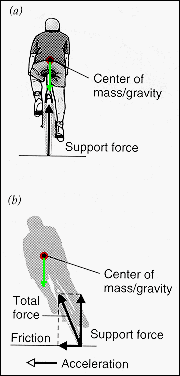|
Forces
and Moments
The
diagram shows the forces acting on a bike in a vertical and horizontal
direction. Any drag forces due to the bicycle motion are neglected in these
diagrams. The bicycle / rider system has a mass associated with it and
this is all assumed to be located at the center of mass. In the top picture
(a) the bike is vertical and either at rest or moving in a straight line
at a constant speed. The interaction of the bicycle with the road results
in a vertical reaction, the support force, that is equal in magnitude and
opposite in direction to the force acting on the system mass, m, due to
the acceleration due to gravity, g.
Support force = - (mg).
The minus sign is used to indicate that the force is acting upwards.
In
(b) the bike/rider system is cornering in a constant radius turn. The bike
is moving at a constant speed through the turn. Motion in a circle requires
the acceleration of the mass towards the center of curvature of the turn.
The force to provide this acceleration comes from the friction force between
the tires and the road surface and has a value (mv2/r)
for a circle of radius r. The vertical support force must still balance
the force due to gravity acting on the system and has the magnitude (mg).
The maximum value that the friction force can have is related to this support
force (normal force) through the coefficient of friction, m,
between the tire and the road. Maximum
Friction Force = mmg.
The vector sum of the friction and support forces is the total reaction
force from the road and passes through the center of mass in stable cornering. |
|
|
|
|
|
|
|
|
|
